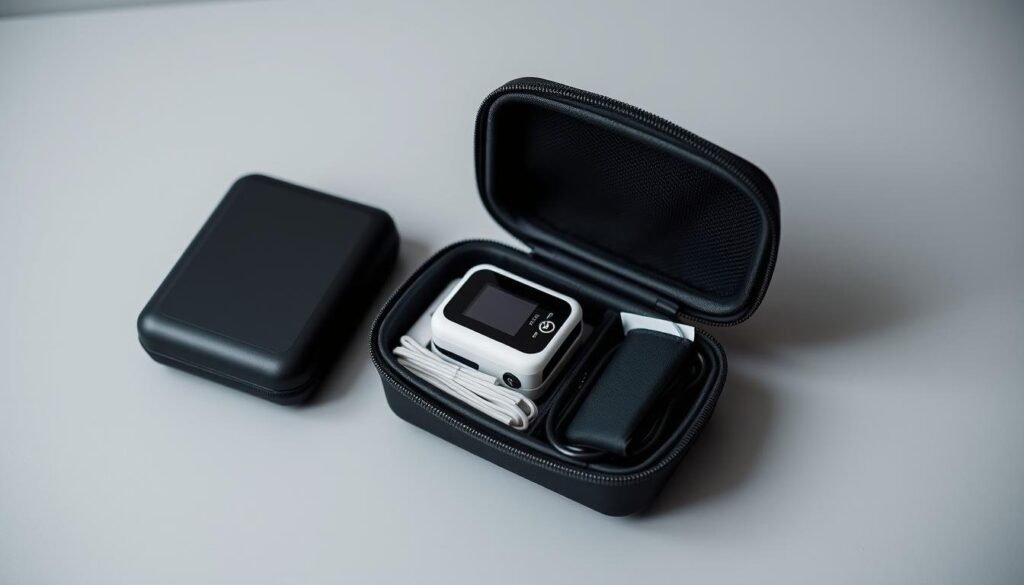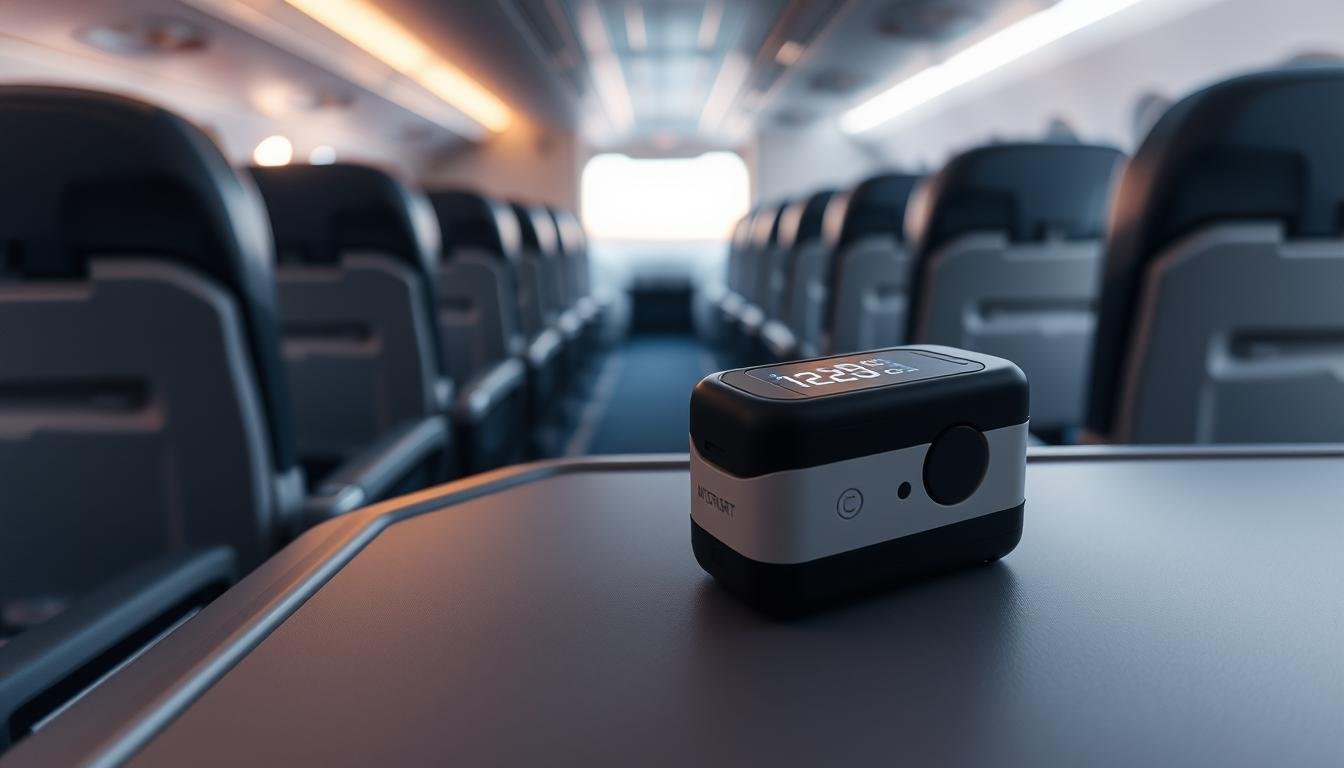Bring a Pulse Oximeter on a Plane: Traveling by air can be tough, especially for those with health issues. If you’re in this group, you might be wondering about the rules for medical devices like pulse oximeters on planes.
It’s important to know the rules for carrying medical gear on flights. This article will help you understand how to bring a pulse oximeter on a plane. We’ll make sure you’re ready for your next trip.
Knowing what to expect can greatly improve your travel experience. We’ll look at the rules and guidelines for using pulse oximeters on flights.
Contents
- 1 Understanding Pulse Oximeters and Travel Needs
- 2 Can You Bring a Pulse Oximeter on a Plane? TSA Regulations
- 3 Airline Policies for Medical Devices
- 4 Packing and Carrying Your Pulse Oximeter
- 5 Using Your Pulse Oximeter During Air Travel
- 6 Conclusion
- 7 FAQ: Bring a Pulse Oximeter on a Plane
- 7.1 Can I bring a pulse oximeter on a plane?
- 7.2 Do I need to inform the TSA about my pulse oximeter?
- 7.3 Are there any specific packing requirements for pulse oximeters?
- 7.4 Can I use my pulse oximeter during the flight?
- 7.5 Are pulse oximeters allowed in carry-on and checked luggage?
- 7.6 What if my pulse oximeter requires a power source during the flight?
Understanding Pulse Oximeters and Travel Needs
When you’re getting ready for your next flight, knowing about pulse oximeters is key. These small devices check your heart rate and blood oxygen levels. They’re especially important for people with health issues like COPD or heart failure.
Traveling by air can be tough on your health because of the lower air pressure and oxygen. For some, this can make health problems worse. Using a pulse oximeter helps you keep an eye on your health and act fast if needed.
| Model | Accuracy | Battery Life | Additional Features |
|---|---|---|---|
| Pulse Oximeter A | ±2% | Up to 24 hours | Bluetooth connectivity, alarm system |
| Pulse Oximeter B | ±1.5% | Up to 30 hours | Waterproof, long battery life |
| Pulse Oximeter C | ±3% | Up to 12 hours | Compact design, easy to use |
Knowing about the different pulse oximeters and their features helps you pick the right one for your travels. Whether you travel often or just once in a while, staying informed about your health can greatly improve your travel experience.
Can You Bring a Pulse Oximeter on a Plane? TSA Regulations
If you’re planning to bring a pulse oximeter on a plane, knowing TSA rules is key. The TSA lets you carry pulse oximeters in both carry-on and checked bags. But, there are rules to follow for a smooth security check.
When you get to the security checkpoint, tell them about your pulse oximeter. This can make the screening easier. Be ready to explain why you need it to TSA officers if they ask.
Medical Necessity Letters
Having a medical necessity letter can help when you travel with a pulse oximeter. Your doctor’s letter explains why you need it. It can answer any questions TSA officers might have, making things go faster.
- Make sure the letter is from your doctor.
- It should have your name and why you need the pulse oximeter.
- Keep it in your carry-on so you can find it quickly.
Prescription Information
Having your prescription ready can also be helpful. This shows you really need the pulse oximeter. It might make the security check easier.
To get ready, do the following:
- Write down your prescription details, like the device’s name and your doctor’s contact info.
- Keep this with your travel documents so you can find it easily.
By following TSA rules and having the right documents, like medical necessity letters and prescription info, you can travel with your pulse oximeter more easily. This makes your trip less stressful.
Airline Policies for Medical Devices
When you’re getting ready to fly with your pulse oximeter, knowing the airline’s policy is key. Each airline has its own rules for medical devices on planes. Some might need you to tell them ahead of time or have special ways to store these items.
Looking up your airline’s policy online is a good first step. Most airlines let you bring pulse oximeters in your carry-on or checked luggage. But, it’s important to check this before you go. Some airlines might ask for extra forms or papers for certain devices.
Remember, the TSA has general rules for medical devices, but airlines can have their own rules too. So, it’s best to talk to your airline or check their website for the latest info.
Knowing these policies helps you prepare better for your trip. It keeps you from running into problems at the airport. Following the airline’s rules makes your flight smoother and less stressful.
Packing and Carrying Your Pulse Oximeter
When you’re getting ready to fly with a pulse oximeter, knowing how to pack and carry it is key. The right packing keeps your device safe and follows airline rules.
Lithium Battery Restrictions
Pulse oximeters often use lithium batteries, which have their own airline rules. Always check with your airline about their lithium battery policy. Usually, you can carry spare lithium batteries in your carry-on, but they must be safe from accidental use. You can use tape to cover the battery terminals or a pouch to protect them.
To follow the rules, remember to:
- Make sure your lithium battery’s watt-hour rating is within airline limits.
- Keep your pulse oximeter in your carry-on to keep it safe and handy.
- Keep spare lithium batteries away from metal to avoid short circuits.
Backup Power Options
Having extra power sources is handy when traveling. Think about carrying extra batteries or a portable power bank that fits your pulse oximeter. This way, you can use your device all trip long without a break.

By following these tips, you can have a worry-free trip with your pulse oximeter. Always check with your airline for the latest on their policies for medical devices and lithium batteries.
Using Your Pulse Oximeter During Air Travel
Using a pulse oximeter on a plane helps you monitor your oxygen levels. This is crucial because air pressure and oxygen levels change in flight. It’s important to keep an eye on your health.
You can use your pulse oximeter just like you do at home. It’s a simple device that clips onto your finger.
Portable Oxygen Concentrators
If you need extra oxygen, a Portable Oxygen Concentrator (POC) is a good choice. POCs run on batteries and can be taken on the plane.
CPAP Machines
People who use CPAP machines can bring them on a plane. But, it’s best to tell your airline ahead of time.
| Device | Purpose | Airline Approval |
|---|---|---|
| Portable Oxygen Concentrator | Supplemental Oxygen | Generally Approved |
| CPAP Machine | Sleep Apnea Treatment | Approved with Notification |
Remember to drink water and get up and move around. This helps prevent blood clots.
By following these tips and using your pulse oximeter, you can have a safe and healthy flight.
Conclusion
Now you know how to travel with your pulse oximeter. You can follow TSA rules and airline policies for a smooth trip. This way, you can take your pulse oximeter anywhere without worry.
When you travel, pack your pulse oximeter safely. Tell security about it at checkpoints. And use it as needed during the flight. This makes sure you stay healthy and enjoy your trip.
Before you go, check with your airline about medical devices. Knowing what they need helps you travel safely and keep your health in check.
See Also: Can You Bring a Pumpkin on a Plane?
FAQ: Bring a Pulse Oximeter on a Plane
Can I bring a pulse oximeter on a plane?
Yes, you can bring a pulse oximeter on a plane. But, it’s wise to check with your airline first. They might have special rules for medical devices.
Do I need to inform the TSA about my pulse oximeter?
It’s not required, but it’s smart to be ready. Explain why you need your pulse oximeter. Have a doctor’s note or prescription ready.
Are there any specific packing requirements for pulse oximeters?
Yes, there are. Know about lithium battery rules. Also, think about backup power to keep your device working while you travel.
Can I use my pulse oximeter during the flight?
Usually, yes. But, always follow the airline’s rules and what the flight crew says. It’s also good to know how to use it safely in the air.
Are pulse oximeters allowed in carry-on and checked luggage?
Pulse oximeters are usually okay in both carry-on and checked bags. But, it’s best to check with your airline for their exact rules.
What if my pulse oximeter requires a power source during the flight?
Think about using a portable power bank or other backup power. Also, know about any rules on power sources in your luggage.

Hello, I’m Janiyah Gibbs—a retired flight crew member and former TSA officer from Alaska, USA. At PlaneCarry.com, I share expert insights on what to carry (and avoid) when flying.

